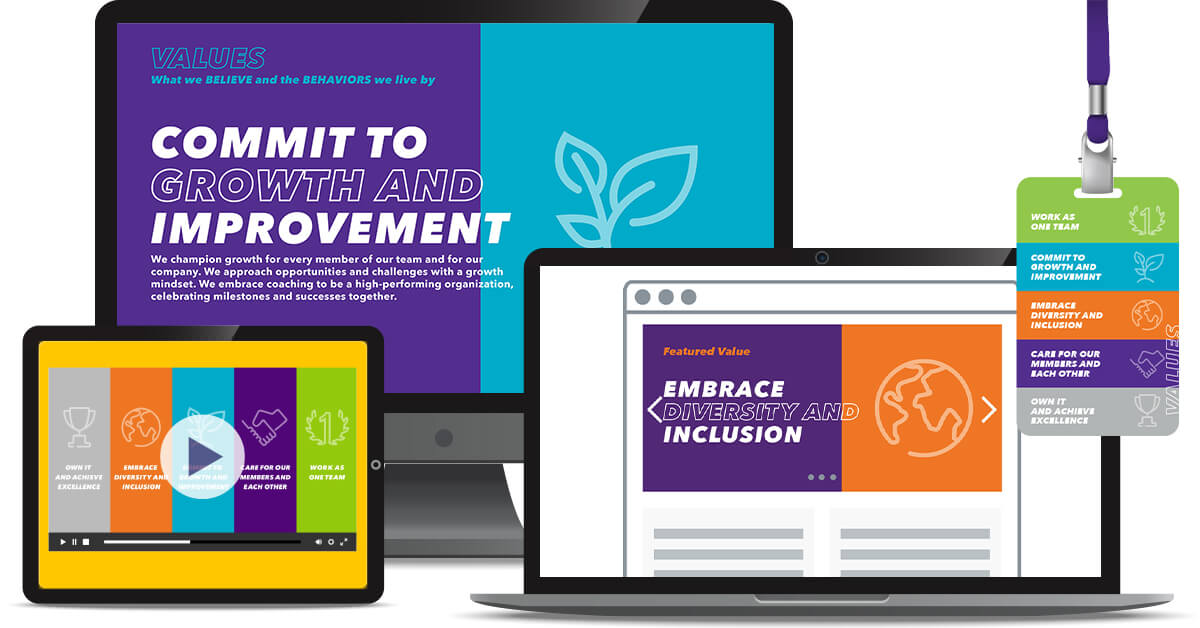Blog
Activate, Elevate and Reinforce Values with Visual Communication
|

Blog
Activate, Elevate and Reinforce Values with Visual Communication
|

Values define what an organization believes and the behaviors it agrees to live by every day. They provide direction for decision-making and clarify expectations for how employees should act when interacting with customers, colleagues and partners.
Values are only effective when widely understood and adopted by employees. Internal communication about values must stand out and establish quick emotional connections to cut through the influx of digital content employees receive each day.
Strategic communication supported by compelling visuals and graphic design helps capture employee attention, promotes understanding of the values and reinforces what the values mean to the organization and its employees. Recent research from TechSmith indicates two out of three employees complete tasks better when communicated visually rather than non-visually. They also consume visual information seven percent faster.
Visual communication aligned to values can unite a strong workforce of engaged and motivated employees who are ready and willing to embrace the values in their daily work.
Visual communication holds power to unify employees
Employees feel connected to their organization’s visual brand elements when they stand for something core and authentic to the business. Companies that align their values to strong graphic design with the following recommendations can better create emotional connections and memorable experiences for employees.
1. Include values in corporate identity
A corporate identity includes all visual elements (e.g., logo, colors, typography) an organization uses to visually represent itself to its audiences. It must align with the organization’s purpose, mission and values to represent the brand with authenticity and evoke emotion with the intended audiences. A corporate identity boils down complex concepts (like values) to simple graphics that carry meaning and significance.
Organizations that develop icons, symbols and colors for each of their values can quickly distinguish which value they’re referencing. Eventually, employees will understand and recognize which value each visual represents. These visuals provide cues that create a deeper understanding of and connection to each value. These icons and symbols help organizations reinforce their values and communicate about them more efficiently and effectively.
CASE STUDY | GEHA

Creating a transformational culture with employees unified around mission, vision and values.
2. Develop a shared visual system to deepen connection to values and culture
Visual communication can create ownership, belonging and pride in an employee for their workplace. There are many creative ways that organizations can develop shared visual systems that reinforce the workplace culture and values through visual elements.
At Beehive, we created a custom Slack emoji that employees can send to one another to express their appreciation. Our “appreciation jar” emoji reflects our culture of gratitude and values of positivity, authenticity and collaboration. It’s become a well-loved element of our culture. Some employees even catch themselves searching for the appreciation jar when texting with friends outside of work, which is a positive sign that our employees authentically embody our values at and outside of work.

Beehive’s “appreciation jar” emoji reflects our culture of gratitude and values of positivity, authenticity and collaboration.
Some organizations create a similar sense of pride among employees by distributing highly coveted company-branded swag. Others might reinforce their values by designing stickers or pins for each of their values and awarding them to employees who consistently embody the values. Simple visual representations of the brand, culture and values can create excitement and engagement among teams.
3. Reinforce values through different visual formats
Visuals are also effective at helping employees sort and prioritize information. Organizations can support and elevate internal priorities and capture their employees’ attention with visual communication aligned to their values. Taking a thoughtful and strategic approach to graphic design can help the company draw attention to the most important messages, signaling to employees that the information communicated deserves their attention. Organizations can use various visual formats to consistently reinforce their values. Some examples include:
- Screensavers that visually depict and reinforce the meaning of each value
- Slide templates that leaders can easily add to presentations to communicate about and reinforce the values
- A well-designed, one-page report that defines key strategic business elements, like purpose, mission and value and helps employees quickly understand them
- Email templates that incorporate graphics and icons created for each value into company-wide emails
- Posters and digital signage on screens displayed in common areas at offices and other work locations
Communication teams and graphic designers should audit the channels available, then identify creative opportunities to reinforce their organization’s values with icons, illustrations and other graphic cues.
Organizations can foster a sense of unity, belonging, ownership and pride when using graphic design to activate and reinforce their values. Visual communication can cut through the digital clutter to capture employee attention, establish an emotional bond and promote understanding and action. Organizations that augment their internal communication with values-aligned visuals can build a stronger workplace culture of motivated and engaged employees.


